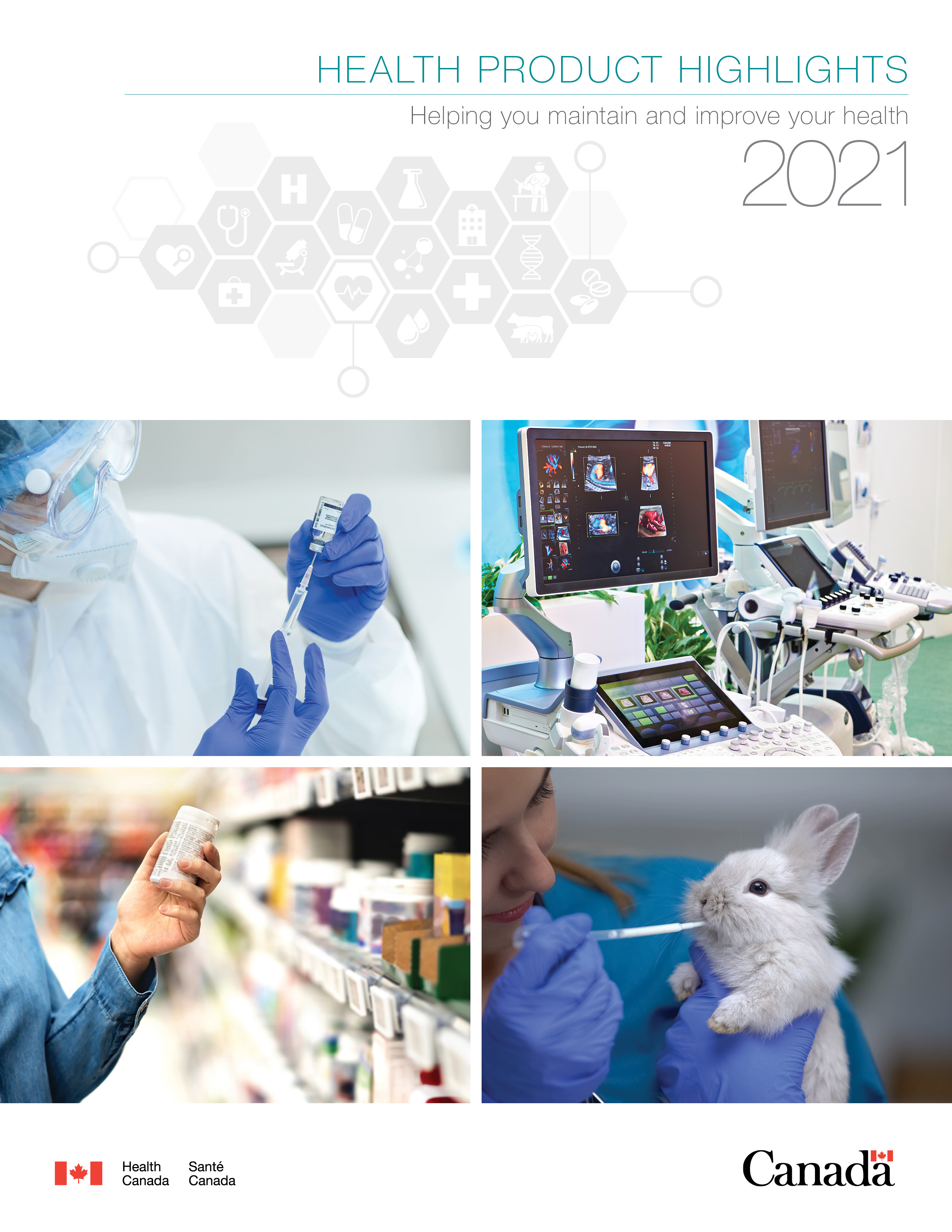Health product highlights 2021: Helping you maintain and improve your health
Download in PDF format
(10.7 MB, 84 pages)
Organization: Health Canada
Date published: August 2022
Cat.: H161-13E-PDF
ISSN: 2816-7104
Pub.: 220301
Health Canada helps Canadians maintain and improve their health by providing timely access to safe, effective and high-quality health products, including prescription and non-prescription drugs, medical devices, natural health products and veterinary health products. Learn about the new health products that Health Canada approved for sale in Canada, the information we published about these products, and our other accomplishments in 2021.
On this page
- Welcome to our 2021 health product highlights report
- Message from the Chief Medical Advisor
- Message from the Chief Regulatory Officer
Welcome to our 2021 health product highlights report
2021 was the second year of an unprecedented global pandemic. The Health Products and Food Branch of Health Canada was proud to play its part as Canada’s health products regulator to ensure Canadians had access to safe, effective and high-quality COVID-related products, including vaccines, tests, treatments, personal protective equipment, disinfectants and sanitizers – in addition to the great number of non-COVID health products Canadians rely on every day.
The COVID-19 response has required a massive collective effort. Our team showed up every day – in the labs, at their desks, from their homes – all while facing the same struggles as their fellow Canadians. Through it all, they delivered by reviewing critically needed COVID-19 products on shortened timelines while maintaining Health Canada’s rigorous scientific standards.

Assistant Deputy Minister

Associate Assistant Deputy Minister
Our work continues even after we review and authorize health products for use in Canada. We continue to monitor COVID-19 products and provide updated safety information as additional data becomes available. Combatting misinformation in marketing has been more important than ever. We track false and misleading claims about COVID-19 products and issue science-based advice. This, along with our efforts to enhance the transparency of health product information provided to Canadians, helps to ensure that they are able to make informed decisions.
We want to acknowledge the extraordinary efforts of our employees – a team highly specialized across a variety of disciplines – in bringing their expertise to bear to help Canadians through this health crisis. Their work has built trust in our regulatory system, provided clear, authoritative information to the public, and above all, ensured the safety, efficacy and quality of thousands of new products – enabling access to both COVID-related products while continuing to review and authorize the many other health products Canadians rely on.
We would be remiss if we did not also mention the contributions of Pierre Sabourin, who retired from the public service in December 2021. He led the Health Products and Food Branch as Assistant Deputy Minister for six years, including through the demanding first 20 months of the COVID-19 pandemic. His dedication and commitment to public service have been outstanding.
An enormous amount of stakeholder collaboration has also taken place over the past two years. We are one piece of the broader COVID-19 response, and we have worked with our federal government partners, provincial and territorial governments, product sponsors, including manufacturers and researchers, and health care practitioners on a scale that we have never seen before. This included scanning for emerging COVID-19 products, and proactively engaging with manufacturers to encourage them to submit their products for approval in Canada. We also continued to prioritize collaboration with our international regulatory partners, in order to support timely access to new products for Canadians. We hope to build on these relationships going forward.
We deepened our relationship with patients and strengthened our efforts to support underserved and/or underrepresented populations, as well as to address rare diseases. In this report, we profile our new Sex- and Gender-Based Analysis Plus Action Plan which is designed to help those who live in Canada make informed decisions regarding treatment options that are based on safety and efficacy profiles of people like them.
This report describes the new health products Health Canada approved for sale in Canada in 2021, the information we published about these products, and how we continued to monitor approved products once on the Canadian market. It also speaks to our efforts to continuously improve our work, ensure that our regulatory system is agile and responsive to innovation, and maintain our rigorous safety standards.
For information on our activities, we invite you to follow @GovCanHealth on Twitter to learn about newly approved drugs and medical devices.
Focus on … COVID-19 products by the numbers
From the start of the COVID-19 pandemic to December 2021, we approved:
- 4 vaccines
- 4 drug treatments
- 113 clinical trial applications for drugs and vaccines
- 62 investigational testing applications for medical devices
- 783 medical devices, including 102 testing devices
- Over 700 disinfectants as effective against COVID-19
- Over 4,000 hand sanitizers
Health Canada continues to monitor the safety and efficacy of all COVID-19-related products. We issued 21 risk communications for COVID-19 treatments and vaccines, and took action on 530 COVID-19-related false and misleading advertisements.
Message from the Chief Medical Advisor

Chief Medical Advisor
The second year of a pandemic demanded much from Health Canada in its regulatory work: resilience, endurance and persistence.
As days turned into weeks, weeks into months, and now months into years, those at the forefront of making and supporting important decisions on access to COVID-19 tests, treatments and vaccines found themselves continuing to work “flat out.” Although we are not personally at the front lines of the health care system, the products that we regulate play a crucial role in every moment of care offered to Canadians.
Waves of the pandemic brought increased demands on energy and resources for key time-sensitive decisions, and once those were completed, the resilience to quickly move onto the next critical task at hand. This of course was set against the backdrop of the challenges that we all were collectively facing outside of work, as well.
Sustaining that level of effort over the long run requires endurance. For COVID-19 health products, the volume of work, the long days necessary to support international collaboration and attention to detail that would be scrutinized to the highest degree were part and parcel of our day-to-day work. Likewise, maintaining standards for non-COVID-related products that are equally important in helping to improve and maintain the health of Canadians meant that reviews and assessments continued to be completed within committed timelines.
Lastly, communicating our work necessitated a great deal of persistence. Continuing the journey along the path of greater openness and transparency required consistent and clear messaging on all decisions. Cutting through the reams of information and often misinformation is still challenging, but we all recognize that accurate and reliable information is the cornerstone to informed decision-making. Undoubtedly, there will be lessons learned on how to best operate in these charged environments.
If this seems like a very personal message this year, it’s because it is. The strength and achievements of the Health Products and Food Branch of Health Canada rest with the individuals who gave their best every day to support Canadians through these challenging times.
Message from the Chief Regulatory Officer

Chief Regulatory Officer
Health Canada’s Regulatory Innovation Agenda responds directly to calls from stakeholders for more modern, agile regulations. These modernization efforts will help to strengthen the health care system by enabling access to more diverse treatment options for Canadians. In 2021, we continued to advance the five key pillars of the agenda:
- Modernizing clinical trial regulations
- Enabling Advanced Therapeutic Products
- Agile licensing for drugs
- Agile licensing for medical devices
- Mobile-first communications strategy
The COVID-19 pandemic has reinforced the importance of agile regulations to enable us to rapidly respond to extraordinary health events and accommodate innovative new products. Some of the agile regulatory tools we used during the pandemic were already a part of our modernization plans. These regulatory measures, in addition to the exceptional response from our staff, allowed us to expedite reviews of COVID-19 health products without compromising safety, efficacy and quality standards. These measures included, for example, reviewing evidence on a rolling basis as it became available, instead of waiting for completed submission packages, and using terms and conditions on product approvals to facilitate continued monitoring once the products were available to Canadians.
One of the key ways in which we were able to advance our agile regulatory response to the pandemic was through Interim Orders – one of the fastest mechanisms available to the federal government to help make health products available to address larger-scale public health emergencies. In 2021, we made sure that the regulatory flexibilities from these Interim Orders remained in place so that Canadians continued to benefit from timely access to COVID-19 health products.
Despite the demands of the pandemic, in 2021, we advanced a wide array of regulatory initiatives to update Canada’s regulatory system for health products. These included consulting on our proposed approach to modernize Canada’s clinical trial regulations, as well as publishing a Notice of Intent in the Canada Gazette on our intentions to expand the use of some key agile regulatory tools used in COVID-19 for other types of drugs and devices. We also published proposed regulations for formal consultation in the Canada Gazette, Part I, to improve the labelling of natural health products.
We look forward to continued collaboration with stakeholders and health care system partners in developing regulatory and policy changes that will contribute to the health and safety of Canadians and modernize our regulatory frameworks.
Focus on … Enhancing our collaboration

Director General, Policy, Planning and International Affairs
Over the past five years, Health Canada has increased its efforts to collaborate with stakeholders and partners in Canada and around the world. These relationships have helped us come together to respond to the pandemic, and also to advance key health system priorities such as increasing access to drugs designed to treat rare diseases.
From an international perspective, we have worked to enhance regulatory alignment and scientific cooperation, as well as conducting more collaborative reviews of health products, all with the goal of enhancing our product approval processes, and bringing needed drugs and medical devices to Canadians more quickly.
Examples of these efforts include our work as part of the Access Consortium, with the United States Food and Drug Administration through Project Orbis, as well as through the International Coalition of Medicines Regulatory Authorities and the European Medicines Agency’s OPEN initiative – which are all discussed in more detail in this report.
Collaboration at home and internationally helps us to fulfill our mandate to ensure that Canadians have access to safe, high-quality and effective health products.
Focus on … Ensuring transparency

Director General, Resource Management and Operations
Health Canada has been steadily increasing transparency about our decisions, and the data that underpin them, as demonstrated by the information we provide to Canadians on COVID-19 vaccines and treatments via our portal.
Our Public Release of Clinical Information initiative continues to support Canada’s response to COVID-19 while expanding its work to proactively make more anonymized clinical information publicly available. The initiative supports Canada’s objective for transparent decision-making and provides valuable information that could help with the use or development of drugs and medical devices. In 2021, we published 1.8 million pages of anonymized clinical data. Part of this work focused on expedited publication of clinical information for COVID-19 vaccines and treatments, many in collaboration with the European Medicines Agency.
This level of transparency supports our overall goal of providing timely, evidence-based and authoritative information to enable Canadians to make informed decisions.
Focus on … Sex- and Gender-Based Analysis Plus
Health Canada continues to strengthen the integration and application of Sex- and Gender-Based Analysis Plus (SGBA Plus) within all our activities to advance equity, diversity and inclusion. Incorporating diverse identity factors, such as sex, gender, race, age and geography, into data collection and decision-making helps us assess the impacts of biological and social differences on how health products work in different populations.
In June 2021, HPFB’s SGBA Plus Action Plan was endorsed by the Deputy Minister. Ultimately, the vision of the plan is that Canadians have access to information to support informed decision-making regarding their treatment options based on safety and efficacy profiles of people like them. Specifically, the goals of the action plan are to:
- Improve the equity-related data that gets submitted to Health Canada (e.g., submission of disaggregated data, increased diversity in clinical trials leading to better data submission, etc.);
- Enhance the way equity-related data is analyzed and reported on by Health Canada; and
- Increase the SGBA Plus information available to the users of the data to build trust and transparency.
In 2021, we also continued to leverage the Scientific Advisory Committee on Health Products for Women (SAC-HPW) to advance work to improve the safety of health products for women. This included engaging the Committee and patient representatives on how to better communicate information to existing and prospective consumers of breast implants and urinary meshes through our website and advisories, as well as initiating discussions on enhanced integration of SGBA Plus into our scientific and policy activities.
We also consulted on draft guidance for clinical evidence requirements for medical devices in November 2021. The draft guidance provides advice to manufacturers on how to incorporate SGBA Plus into their applications for a medical device license. This analysis supports Health Canada’s review of a medical device, helping to confirm safety and that the devices function appropriately for different groups of patients.
